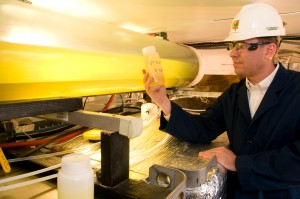 This week I read the book called “The Green Miracle,” by Clayton McNeff who is one of the creators of the Mcgyan Process. It’s the story of how in less than four years, with the inkling of an idea from a college student, a new multi-feedstock production technology was created to produce biodiesel.
This week I read the book called “The Green Miracle,” by Clayton McNeff who is one of the creators of the Mcgyan Process. It’s the story of how in less than four years, with the inkling of an idea from a college student, a new multi-feedstock production technology was created to produce biodiesel.
In 2006, McNeff was contacted by one of his former undergraduate college professors, Arlin Gyberg, at Augsburg College located in Minneapolis, Minnesota, on behalf of one of his chemistry students, Brian Krohn. Krohn, a sophomore at the time, and now Rhodes Scholar, was going to conduct a 10-week summer research project on biodiesel. Krohn wanted to pursue producing biodiesel using a catalyst after his research uncovered some relatively unknown papers relating to the subject. As McNeff explains, a catalyst is something that speeds up a reaction and does not get consumed in a chemical reaction.
At the time, current biodiesel production was done by a chemical process called “based catalyzed transesterification.” In this process, oil and alcohol are chemically combined to produce esters (biodiesel) in a batch process where the reactants are put in a large tank, heated an stirred vigorously.
Krohn wanted to try using zirconia particles to catalyze the biodiesel reaction and although his experiments didn’t work, he sent along some papers to McNeff and that got his mind working in overtime – to the point where he called a meeting during which he suggested they try the very experiment that led to the Mcgyan Process discovery. The name came about after the research team that created it – Clayton McNeff, Arlin Gyberg and Dr. Ben Yan.
 So how is this process different? It’s a continuous process where you combine an alcohol like ethanol and an oil like corn oil and run it through a reactor filled with a metal oxide catalyst. Then you add heat and pressure to the reactor and in a few seconds contact time the reaction is complete and you have biodiesel. This is all done without chemicals or water. And the Mcgyan Process has yet to meet an oil feedstock it couldn’t covert to ASTM standard biodiesel.
So how is this process different? It’s a continuous process where you combine an alcohol like ethanol and an oil like corn oil and run it through a reactor filled with a metal oxide catalyst. Then you add heat and pressure to the reactor and in a few seconds contact time the reaction is complete and you have biodiesel. This is all done without chemicals or water. And the Mcgyan Process has yet to meet an oil feedstock it couldn’t covert to ASTM standard biodiesel.
If you can shorten a less than four year story even more, after thousands of experiments to understand the chemistry of what they had, the team built a pilot scale facility and from there, a commercial scale 3 million gallon plant called Ever Cat Fuels (Ever Catalyst). In the middle of all of this, McNeff published papers about the findings, raised money, visited Washington, D.C., applied for DOE Loan Guarantees (which are nearly impossible to get for cutting edge, first-time technologies) and did all of this during the worst recession that this country has seen in 80 years.
While McNeff talks about how he believes this discovery and the consequent journey was “meant to be” it was not without its hardships. That’s in part what led he and his family to donate 5 cents from every gallon of biodiesel produced from Ever Cat Fuels to go to build a new science building at Augsburg College – the place where it all began.
I would be remiss to say that there are hundreds, if not thousands of researchers and entrepreneurs out there looking for the next breakthrough. It’s easy to get frustrated. The next time you do. Take a moment to read The Green Miracle. It won’t take long to inspire you and along the way, you’ll be reassured that America does in fact possess the willpower and the ingenuity to bring solutions to market to address our energy crisis today.
You can hear the story of The Green Miracle in Clayton McNeff’s own words in an excerpt of my interview with him: The Green Miracle

